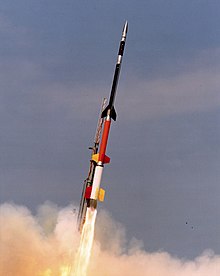Norwegian rocket incident
This article includes a list of references, related reading, or external links, but its sources remain unclear because it lacks inline citations. (November 2010) |

The Norwegian rocket incident (or Black Brant scare) refers to a few minutes of post-Cold War nuclear tension that took place on January 25, 1995, more than four years after the end of the Cold War. The incident started when a team of Norwegian and American scientists launched a Black Brant XII four-stage sounding rocket from the Andøya Rocket Range off the northwest coast of Norway. The rocket, which carried equipment to study the aurora borealis over Svalbard, flew on a high northbound trajectory, which included an air corridor that stretches from the North Dakota Minuteman-III silos all the way to Moscow, eventually reaching an altitude of 1,453 kilometers (903 mi). Nuclear forces in Russia were put on alert, and the nuclear-command suitcase was brought to President Boris Yeltsin, who then had to decide whether to launch a nuclear barrage against the United States. Notably, there is still no clear and direct confirmation that the trajectory of the rocket was taken by mistake, caused by computer or other technical failure.
Detection
As the rocket climbed, it was detected by the Olenegorsk early warning radar station in Russia. To the radar operators, the rocket appeared similar in speed and flight pattern to a U.S. submarine-launched Trident missile, leading the Russian military to initially misinterpret the rocket's trajectory as representing the precursor to a possible attack by missiles from submarines.
EMP rocket scenario
One possibility was that the rocket had been a solitary radar-blocking electromagnetic pulse (EMP) rocket launched from a Trident missile at sea in order to blind Russian radars in the first stage of a surprise attack. In this scenario, gamma rays from a high-altitude nuclear detonation could create an EMP wave that would confuse radars and incapacitate electronic equipment. After that, according to the scenario, the real attack would start.
Post-staging
After stage separation, the rocket launch appeared on radar similar to multiple re-entry vehicles (MRVs); the Russian control center did not immediately realize that the Norwegian scientific rocket was headed out to sea, rather than toward Russia. Tracking the trajectory took eight of the ten minutes allotted to the process of deciding whether to launch a nuclear response to an impending attack (Trident submarine missiles from the Barents Sea could reach Russia's mainland in ten minutes).
Response
This event resulted in a full alert being passed up through the military chain of command all the way to President Boris Yeltsin, who was notified immediately and the "nuclear briefcase" (known in Russia as Cheget) used to authorize nuclear launch was automatically activated. President Boris Yeltsin activated his "nuclear keys" for the first time. No warning was issued to the Russian populace of any incident; it was reported in the news a week afterward.[1]
As a result of the alert, Russian submarine commanders were ordered to go into a state of combat readiness and prepare for nuclear retaliation.
Russian doctrine in the event of such Cheget alerts is to push the button, no questions asked [citation needed]. In Russia there are three people who have such a Cheget. President Yeltsin was very hesitant to push the button; he couldn't believe that an attack was underway. It is widely held that Yeltsin's hesitation saved the day. After a while Russian observers were able to determine that the rocket was heading away from Russian airspace and was not a threat. The rocket fell to earth as planned, near Spitsbergen, 24 minutes after launch.[1]
While not as well known an incident as the Cuban Missile Crisis of 1962, the incident of January 25, 1995 is considered by many to be much more severe an incident. The incident in 1995 came seemingly unprovoked and at a time after the Cold War where the Russians in general were very suspicious of US/Western actions. The Cuban Missile Crisis had a long build-up and a possible attack during that crisis would have been much better prepared for.[1]
The incident in Norway was the first and only incident where any of the nuclear powers had its nuclear suitcases activated and prepared for launching an attack.[1]
Prior notification
The Norwegian and American scientists had notified thirty countries including Russia of their intention to launch a high-altitude scientific experiment aboard a rocket, however the information was not passed on to the radar technicians.[citation needed] Following the incident, notification and disclosure protocols were re-evaluated and redesigned.
See also
References
- Hoffman, David (March 15, 1998). "Cold-War Doctrines Refuse to Die". The Washington Post. p. A01. Retrieved August 10, 2010.
- Pry, Peter (1999). War scare: Russia and America on the nuclear brink. New York: Praeger. ISBN 0-275-96643-7.
- Phillips, Alan F. (January 1998). "20 Mishaps that Might Have Started Accidental Nuclear War". Retrieved August 10, 2010.
